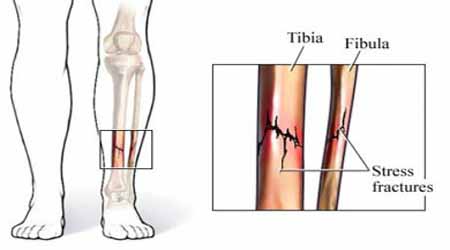A stress fracture is a small crack in the bone. This is frequently seen in athletes, particularly in long-distance runners due to repeated trauma. Stress injuries can occur to the hip, shin bone, foot, heel, and lower back. They are typically treated by lowering your activity level and by resting until the bone heals.
What Signs Point to a Stress Fracture?
Stress fractures often cause dull pain near the fracture site. This pain often gets worse when moving and exercising. Another symptom is localised swelling.
Causes Of Stress Fractures:
The increased intensity or volume of an activity is the most frequent cause of stress fractures. When a bone is subjected to an increasing load, the bone undergoes a remodelling process. However, if the load abruptly increases while remodelling, the bone tissue is damaged. Stress fractures can also occur as a result of the impact of an unknown surface, using the wrong tools, or from increased physical strain. The athletes who compete in track and field, tennis, basketball, and gymnastics are more prone to stress fractures and injuries. Trauma is brought on by the constant tension of the foot impacting the ground. Stress fractures in athletes can result from not getting enough recovery time in between sessions or events.

Prevention Of Stress Fractures:
You can avoid stress fractures by taking a few easy precautions.
1. Adjust things gradually
Any new workout routine should be started carefully and advanced over time.
1. Put on the right shoes
Make sure your shoes are comfortable and suitable for the activity. Ask your doctor about shoe arch supports if you have flat feet.
1. Cross-train
To prevent repeatedly stressing one area of your body, include low-impact exercises in your exercise routine.
1. Consume healthy food
Make sure your diet contains adequate calcium, vitamin D, and other nutrients to maintain your bones strong.
Treatment Of Stress Fractures With PRP:
Rest is the most crucial stress fracture treatment. The task or activity that caused the fracture must be put on hold for the patients. Larger and more serious fractures could develop if the patient keeps performing the activity that injured them. Additionally, it may result in fractures that never heal. The patients are also given braces in several cases. But aside from rest and other therapies, platelet rich plasma therapy, often known as PRP therapy, is the most efficient technique to heal stress fractures. After treating the afflicted area with numerous additional growth factors, PRP, which is made exclusively from the patient's body, is injected into it. PRP therapy enables quick healing with the greatest outcomes.










